PS558 - Conceptual and Historical Issues: Little Albert Experiment
VerifiedAdded on 2023/06/12
|9
|2739
|133
Essay
AI Summary
This essay provides a comprehensive analysis of John B. Watson's Little Albert experiment, a pivotal study in the history of psychology that demonstrated the principles of classical conditioning. The experiment, conducted at John Hopkins University, involved conditioning a young child, Little Albert, to fear a white rat and other similar stimuli through the association of the rat with a loud, startling noise. The essay explores Watson's background and influences, including Ivan Pavlov's work on classical conditioning, and examines the methodology, results, and ethical implications of the Little Albert experiment. It also discusses the experiment's impact on the development of behaviorism and its continued relevance in understanding the acquisition of phobias and other emotional responses. Furthermore, the essay considers criticisms of the experiment and its lasting legacy in the field of psychology, highlighting its significance in research areas such as psychotherapy and parenting. The document is available on Desklib, a platform offering a range of study tools for students.
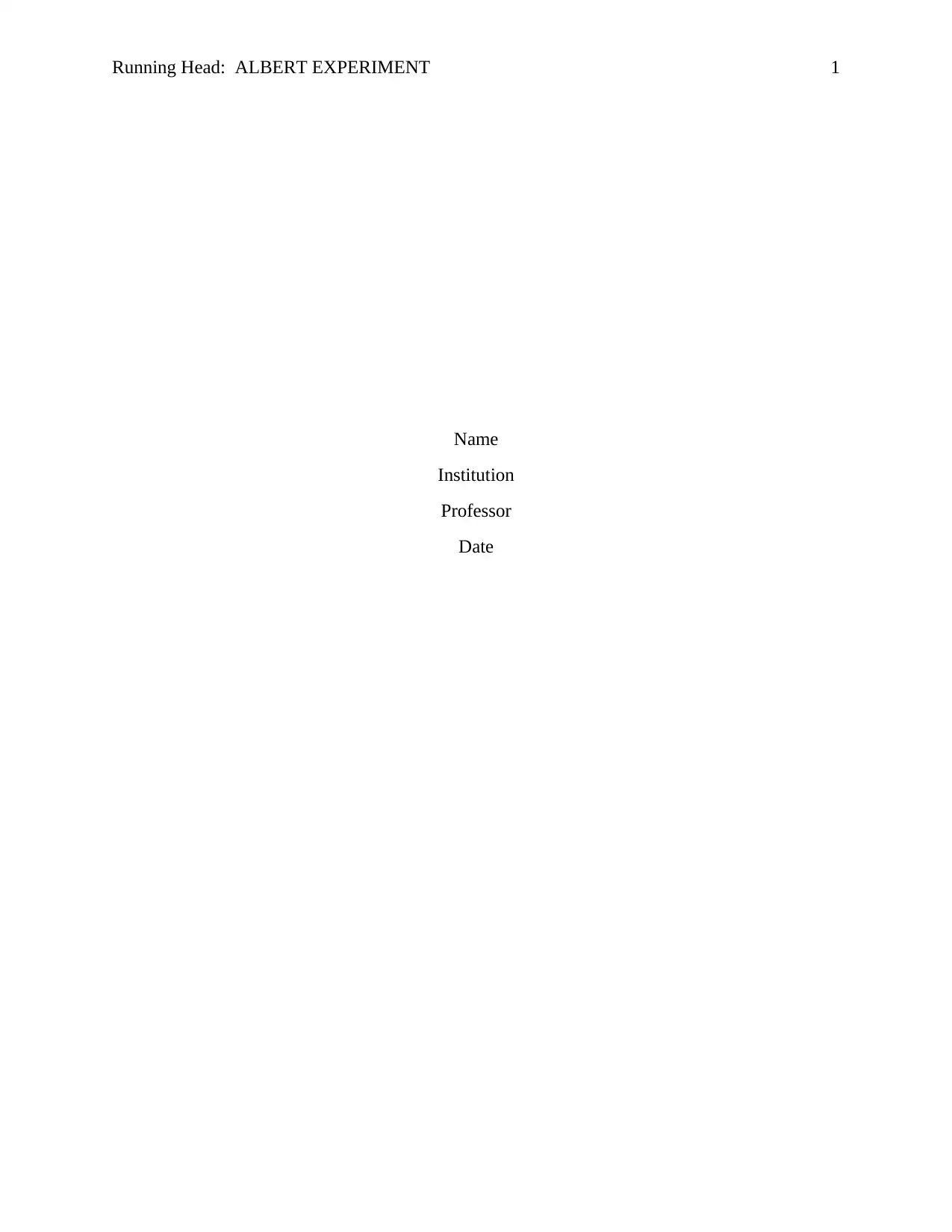
Running Head: ALBERT EXPERIMENT 1
Name
Institution
Professor
Date
Name
Institution
Professor
Date
Secure Best Marks with AI Grader
Need help grading? Try our AI Grader for instant feedback on your assignments.
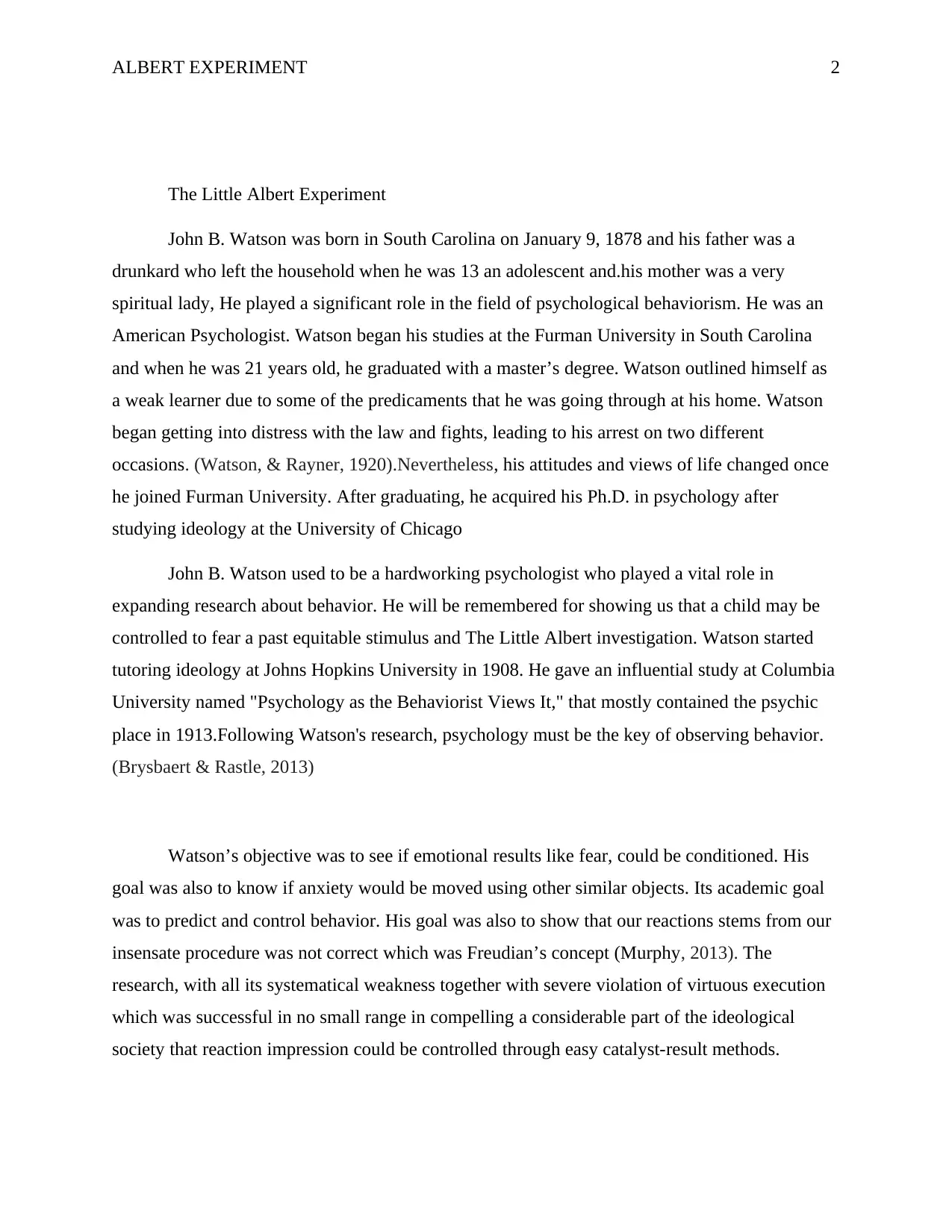
ALBERT EXPERIMENT 2
The Little Albert Experiment
John B. Watson was born in South Carolina on January 9, 1878 and his father was a
drunkard who left the household when he was 13 an adolescent and.his mother was a very
spiritual lady, He played a significant role in the field of psychological behaviorism. He was an
American Psychologist. Watson began his studies at the Furman University in South Carolina
and when he was 21 years old, he graduated with a master’s degree. Watson outlined himself as
a weak learner due to some of the predicaments that he was going through at his home. Watson
began getting into distress with the law and fights, leading to his arrest on two different
occasions. (Watson, & Rayner, 1920).Nevertheless, his attitudes and views of life changed once
he joined Furman University. After graduating, he acquired his Ph.D. in psychology after
studying ideology at the University of Chicago
John B. Watson used to be a hardworking psychologist who played a vital role in
expanding research about behavior. He will be remembered for showing us that a child may be
controlled to fear a past equitable stimulus and The Little Albert investigation. Watson started
tutoring ideology at Johns Hopkins University in 1908. He gave an influential study at Columbia
University named "Psychology as the Behaviorist Views It," that mostly contained the psychic
place in 1913.Following Watson's research, psychology must be the key of observing behavior.
(Brysbaert & Rastle, 2013)
Watson’s objective was to see if emotional results like fear, could be conditioned. His
goal was also to know if anxiety would be moved using other similar objects. Its academic goal
was to predict and control behavior. His goal was also to show that our reactions stems from our
insensate procedure was not correct which was Freudian’s concept (Murphy, 2013). The
research, with all its systematical weakness together with severe violation of virtuous execution
which was successful in no small range in compelling a considerable part of the ideological
society that reaction impression could be controlled through easy catalyst-result methods.
The Little Albert Experiment
John B. Watson was born in South Carolina on January 9, 1878 and his father was a
drunkard who left the household when he was 13 an adolescent and.his mother was a very
spiritual lady, He played a significant role in the field of psychological behaviorism. He was an
American Psychologist. Watson began his studies at the Furman University in South Carolina
and when he was 21 years old, he graduated with a master’s degree. Watson outlined himself as
a weak learner due to some of the predicaments that he was going through at his home. Watson
began getting into distress with the law and fights, leading to his arrest on two different
occasions. (Watson, & Rayner, 1920).Nevertheless, his attitudes and views of life changed once
he joined Furman University. After graduating, he acquired his Ph.D. in psychology after
studying ideology at the University of Chicago
John B. Watson used to be a hardworking psychologist who played a vital role in
expanding research about behavior. He will be remembered for showing us that a child may be
controlled to fear a past equitable stimulus and The Little Albert investigation. Watson started
tutoring ideology at Johns Hopkins University in 1908. He gave an influential study at Columbia
University named "Psychology as the Behaviorist Views It," that mostly contained the psychic
place in 1913.Following Watson's research, psychology must be the key of observing behavior.
(Brysbaert & Rastle, 2013)
Watson’s objective was to see if emotional results like fear, could be conditioned. His
goal was also to know if anxiety would be moved using other similar objects. Its academic goal
was to predict and control behavior. His goal was also to show that our reactions stems from our
insensate procedure was not correct which was Freudian’s concept (Murphy, 2013). The
research, with all its systematical weakness together with severe violation of virtuous execution
which was successful in no small range in compelling a considerable part of the ideological
society that reaction impression could be controlled through easy catalyst-result methods.
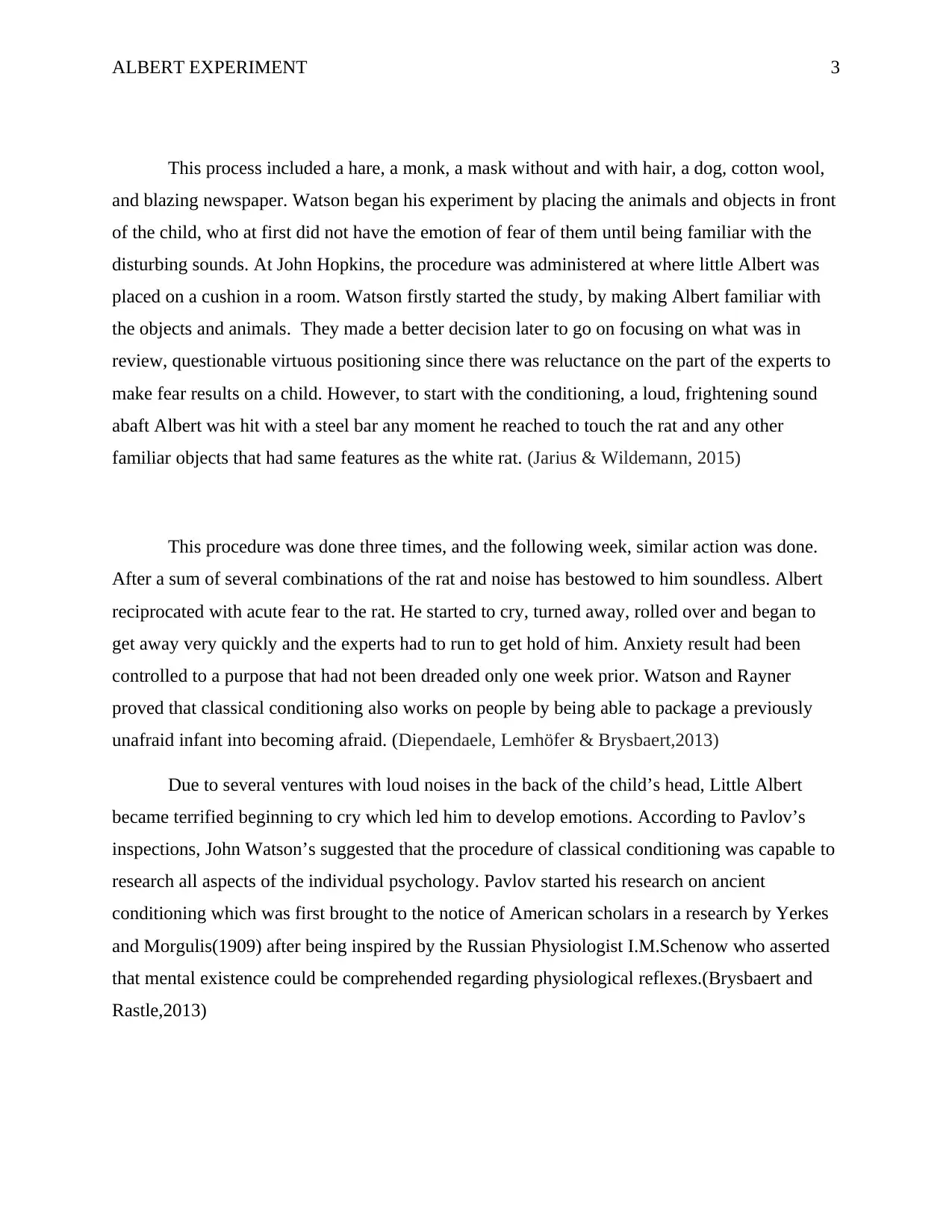
ALBERT EXPERIMENT 3
This process included a hare, a monk, a mask without and with hair, a dog, cotton wool,
and blazing newspaper. Watson began his experiment by placing the animals and objects in front
of the child, who at first did not have the emotion of fear of them until being familiar with the
disturbing sounds. At John Hopkins, the procedure was administered at where little Albert was
placed on a cushion in a room. Watson firstly started the study, by making Albert familiar with
the objects and animals. They made a better decision later to go on focusing on what was in
review, questionable virtuous positioning since there was reluctance on the part of the experts to
make fear results on a child. However, to start with the conditioning, a loud, frightening sound
abaft Albert was hit with a steel bar any moment he reached to touch the rat and any other
familiar objects that had same features as the white rat. (Jarius & Wildemann, 2015)
This procedure was done three times, and the following week, similar action was done.
After a sum of several combinations of the rat and noise has bestowed to him soundless. Albert
reciprocated with acute fear to the rat. He started to cry, turned away, rolled over and began to
get away very quickly and the experts had to run to get hold of him. Anxiety result had been
controlled to a purpose that had not been dreaded only one week prior. Watson and Rayner
proved that classical conditioning also works on people by being able to package a previously
unafraid infant into becoming afraid. (Diependaele, Lemhöfer & Brysbaert,2013)
Due to several ventures with loud noises in the back of the child’s head, Little Albert
became terrified beginning to cry which led him to develop emotions. According to Pavlov’s
inspections, John Watson’s suggested that the procedure of classical conditioning was capable to
research all aspects of the individual psychology. Pavlov started his research on ancient
conditioning which was first brought to the notice of American scholars in a research by Yerkes
and Morgulis(1909) after being inspired by the Russian Physiologist I.M.Schenow who asserted
that mental existence could be comprehended regarding physiological reflexes.(Brysbaert and
Rastle,2013)
This process included a hare, a monk, a mask without and with hair, a dog, cotton wool,
and blazing newspaper. Watson began his experiment by placing the animals and objects in front
of the child, who at first did not have the emotion of fear of them until being familiar with the
disturbing sounds. At John Hopkins, the procedure was administered at where little Albert was
placed on a cushion in a room. Watson firstly started the study, by making Albert familiar with
the objects and animals. They made a better decision later to go on focusing on what was in
review, questionable virtuous positioning since there was reluctance on the part of the experts to
make fear results on a child. However, to start with the conditioning, a loud, frightening sound
abaft Albert was hit with a steel bar any moment he reached to touch the rat and any other
familiar objects that had same features as the white rat. (Jarius & Wildemann, 2015)
This procedure was done three times, and the following week, similar action was done.
After a sum of several combinations of the rat and noise has bestowed to him soundless. Albert
reciprocated with acute fear to the rat. He started to cry, turned away, rolled over and began to
get away very quickly and the experts had to run to get hold of him. Anxiety result had been
controlled to a purpose that had not been dreaded only one week prior. Watson and Rayner
proved that classical conditioning also works on people by being able to package a previously
unafraid infant into becoming afraid. (Diependaele, Lemhöfer & Brysbaert,2013)
Due to several ventures with loud noises in the back of the child’s head, Little Albert
became terrified beginning to cry which led him to develop emotions. According to Pavlov’s
inspections, John Watson’s suggested that the procedure of classical conditioning was capable to
research all aspects of the individual psychology. Pavlov started his research on ancient
conditioning which was first brought to the notice of American scholars in a research by Yerkes
and Morgulis(1909) after being inspired by the Russian Physiologist I.M.Schenow who asserted
that mental existence could be comprehended regarding physiological reflexes.(Brysbaert and
Rastle,2013)
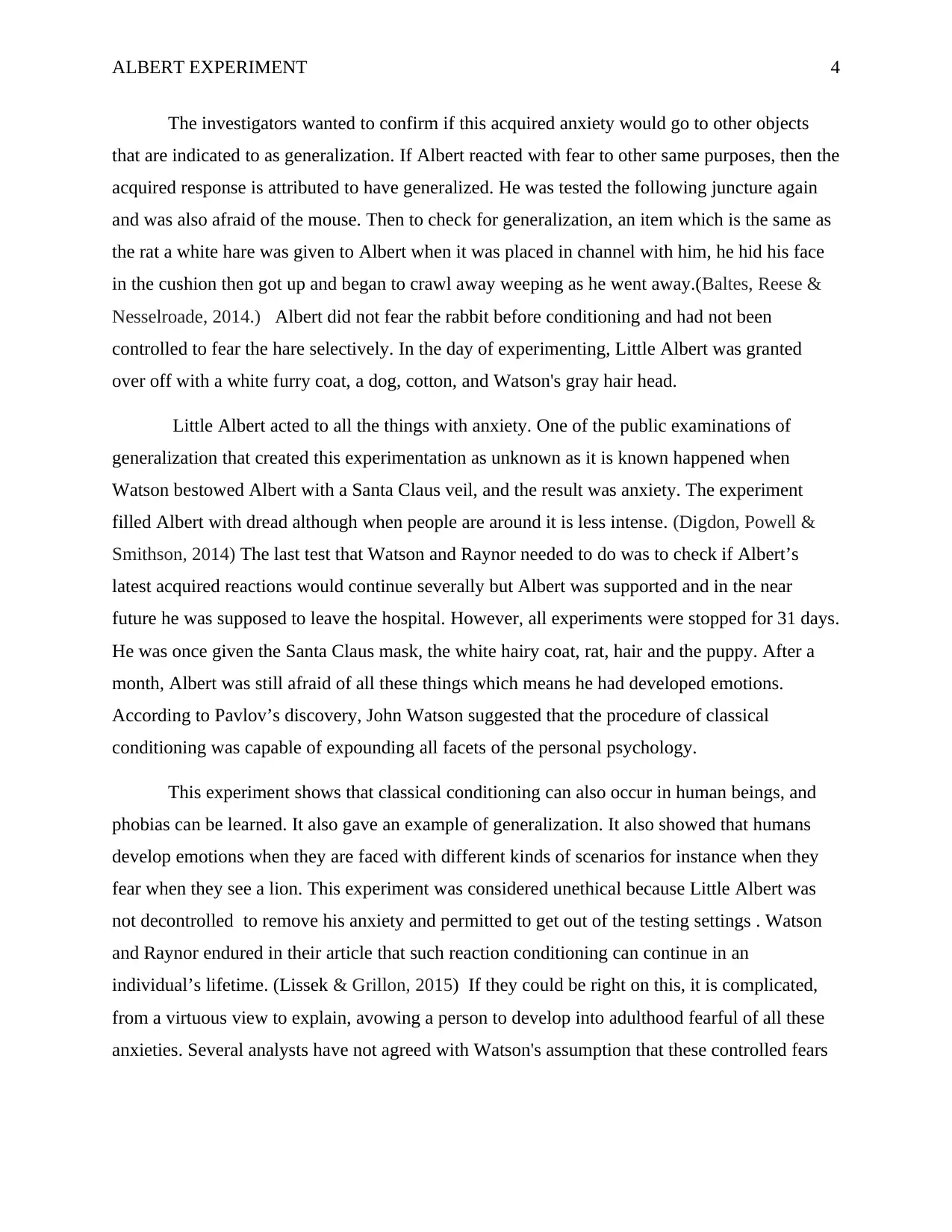
ALBERT EXPERIMENT 4
The investigators wanted to confirm if this acquired anxiety would go to other objects
that are indicated to as generalization. If Albert reacted with fear to other same purposes, then the
acquired response is attributed to have generalized. He was tested the following juncture again
and was also afraid of the mouse. Then to check for generalization, an item which is the same as
the rat a white hare was given to Albert when it was placed in channel with him, he hid his face
in the cushion then got up and began to crawl away weeping as he went away.(Baltes, Reese &
Nesselroade, 2014.) Albert did not fear the rabbit before conditioning and had not been
controlled to fear the hare selectively. In the day of experimenting, Little Albert was granted
over off with a white furry coat, a dog, cotton, and Watson's gray hair head.
Little Albert acted to all the things with anxiety. One of the public examinations of
generalization that created this experimentation as unknown as it is known happened when
Watson bestowed Albert with a Santa Claus veil, and the result was anxiety. The experiment
filled Albert with dread although when people are around it is less intense. (Digdon, Powell &
Smithson, 2014) The last test that Watson and Raynor needed to do was to check if Albert’s
latest acquired reactions would continue severally but Albert was supported and in the near
future he was supposed to leave the hospital. However, all experiments were stopped for 31 days.
He was once given the Santa Claus mask, the white hairy coat, rat, hair and the puppy. After a
month, Albert was still afraid of all these things which means he had developed emotions.
According to Pavlov’s discovery, John Watson suggested that the procedure of classical
conditioning was capable of expounding all facets of the personal psychology.
This experiment shows that classical conditioning can also occur in human beings, and
phobias can be learned. It also gave an example of generalization. It also showed that humans
develop emotions when they are faced with different kinds of scenarios for instance when they
fear when they see a lion. This experiment was considered unethical because Little Albert was
not decontrolled to remove his anxiety and permitted to get out of the testing settings . Watson
and Raynor endured in their article that such reaction conditioning can continue in an
individual’s lifetime. (Lissek & Grillon, 2015) If they could be right on this, it is complicated,
from a virtuous view to explain, avowing a person to develop into adulthood fearful of all these
anxieties. Several analysts have not agreed with Watson's assumption that these controlled fears
The investigators wanted to confirm if this acquired anxiety would go to other objects
that are indicated to as generalization. If Albert reacted with fear to other same purposes, then the
acquired response is attributed to have generalized. He was tested the following juncture again
and was also afraid of the mouse. Then to check for generalization, an item which is the same as
the rat a white hare was given to Albert when it was placed in channel with him, he hid his face
in the cushion then got up and began to crawl away weeping as he went away.(Baltes, Reese &
Nesselroade, 2014.) Albert did not fear the rabbit before conditioning and had not been
controlled to fear the hare selectively. In the day of experimenting, Little Albert was granted
over off with a white furry coat, a dog, cotton, and Watson's gray hair head.
Little Albert acted to all the things with anxiety. One of the public examinations of
generalization that created this experimentation as unknown as it is known happened when
Watson bestowed Albert with a Santa Claus veil, and the result was anxiety. The experiment
filled Albert with dread although when people are around it is less intense. (Digdon, Powell &
Smithson, 2014) The last test that Watson and Raynor needed to do was to check if Albert’s
latest acquired reactions would continue severally but Albert was supported and in the near
future he was supposed to leave the hospital. However, all experiments were stopped for 31 days.
He was once given the Santa Claus mask, the white hairy coat, rat, hair and the puppy. After a
month, Albert was still afraid of all these things which means he had developed emotions.
According to Pavlov’s discovery, John Watson suggested that the procedure of classical
conditioning was capable of expounding all facets of the personal psychology.
This experiment shows that classical conditioning can also occur in human beings, and
phobias can be learned. It also gave an example of generalization. It also showed that humans
develop emotions when they are faced with different kinds of scenarios for instance when they
fear when they see a lion. This experiment was considered unethical because Little Albert was
not decontrolled to remove his anxiety and permitted to get out of the testing settings . Watson
and Raynor endured in their article that such reaction conditioning can continue in an
individual’s lifetime. (Lissek & Grillon, 2015) If they could be right on this, it is complicated,
from a virtuous view to explain, avowing a person to develop into adulthood fearful of all these
anxieties. Several analysts have not agreed with Watson's assumption that these controlled fears
Secure Best Marks with AI Grader
Need help grading? Try our AI Grader for instant feedback on your assignments.
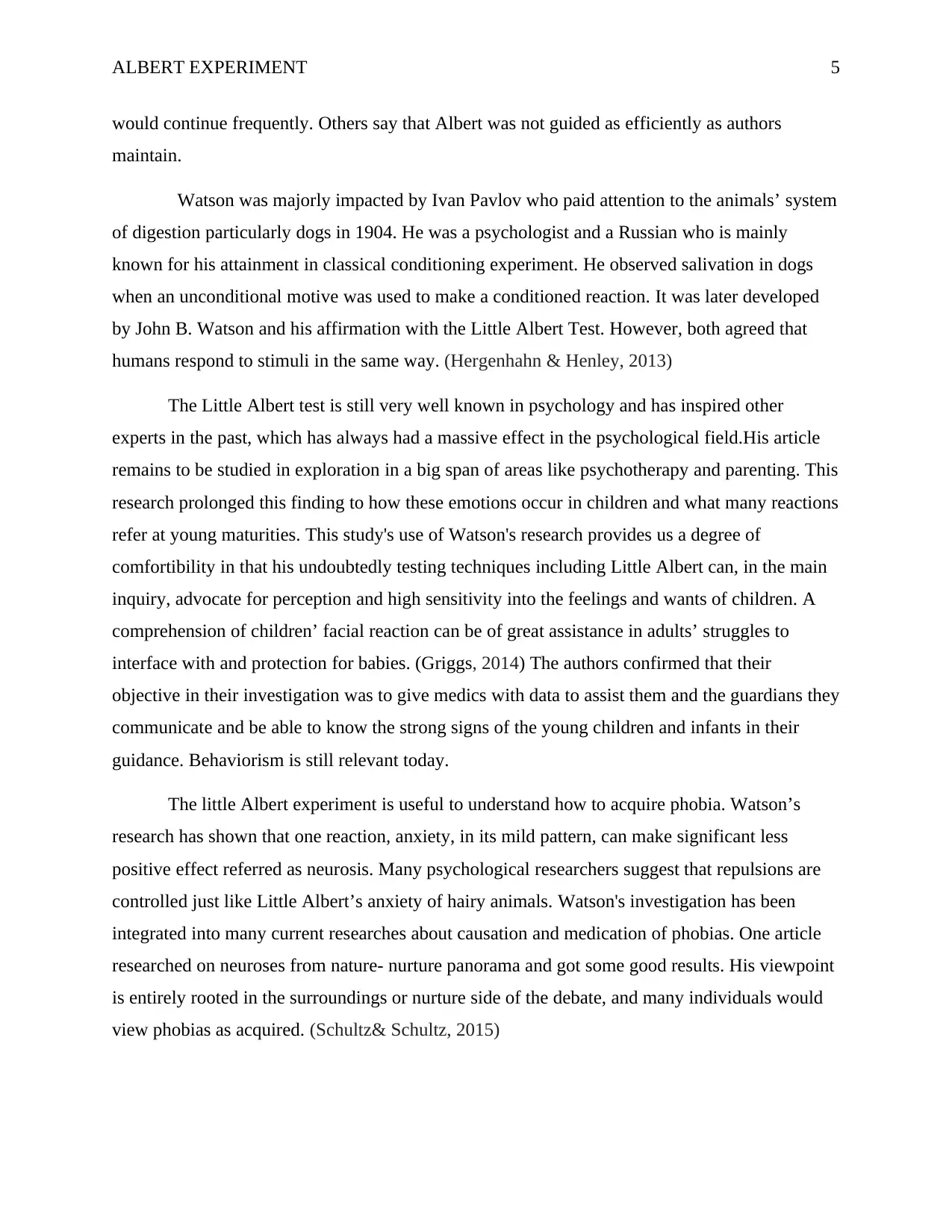
ALBERT EXPERIMENT 5
would continue frequently. Others say that Albert was not guided as efficiently as authors
maintain.
Watson was majorly impacted by Ivan Pavlov who paid attention to the animals’ system
of digestion particularly dogs in 1904. He was a psychologist and a Russian who is mainly
known for his attainment in classical conditioning experiment. He observed salivation in dogs
when an unconditional motive was used to make a conditioned reaction. It was later developed
by John B. Watson and his affirmation with the Little Albert Test. However, both agreed that
humans respond to stimuli in the same way. (Hergenhahn & Henley, 2013)
The Little Albert test is still very well known in psychology and has inspired other
experts in the past, which has always had a massive effect in the psychological field.His article
remains to be studied in exploration in a big span of areas like psychotherapy and parenting. This
research prolonged this finding to how these emotions occur in children and what many reactions
refer at young maturities. This study's use of Watson's research provides us a degree of
comfortibility in that his undoubtedly testing techniques including Little Albert can, in the main
inquiry, advocate for perception and high sensitivity into the feelings and wants of children. A
comprehension of children’ facial reaction can be of great assistance in adults’ struggles to
interface with and protection for babies. (Griggs, 2014) The authors confirmed that their
objective in their investigation was to give medics with data to assist them and the guardians they
communicate and be able to know the strong signs of the young children and infants in their
guidance. Behaviorism is still relevant today.
The little Albert experiment is useful to understand how to acquire phobia. Watson’s
research has shown that one reaction, anxiety, in its mild pattern, can make significant less
positive effect referred as neurosis. Many psychological researchers suggest that repulsions are
controlled just like Little Albert’s anxiety of hairy animals. Watson's investigation has been
integrated into many current researches about causation and medication of phobias. One article
researched on neuroses from nature- nurture panorama and got some good results. His viewpoint
is entirely rooted in the surroundings or nurture side of the debate, and many individuals would
view phobias as acquired. (Schultz& Schultz, 2015)
would continue frequently. Others say that Albert was not guided as efficiently as authors
maintain.
Watson was majorly impacted by Ivan Pavlov who paid attention to the animals’ system
of digestion particularly dogs in 1904. He was a psychologist and a Russian who is mainly
known for his attainment in classical conditioning experiment. He observed salivation in dogs
when an unconditional motive was used to make a conditioned reaction. It was later developed
by John B. Watson and his affirmation with the Little Albert Test. However, both agreed that
humans respond to stimuli in the same way. (Hergenhahn & Henley, 2013)
The Little Albert test is still very well known in psychology and has inspired other
experts in the past, which has always had a massive effect in the psychological field.His article
remains to be studied in exploration in a big span of areas like psychotherapy and parenting. This
research prolonged this finding to how these emotions occur in children and what many reactions
refer at young maturities. This study's use of Watson's research provides us a degree of
comfortibility in that his undoubtedly testing techniques including Little Albert can, in the main
inquiry, advocate for perception and high sensitivity into the feelings and wants of children. A
comprehension of children’ facial reaction can be of great assistance in adults’ struggles to
interface with and protection for babies. (Griggs, 2014) The authors confirmed that their
objective in their investigation was to give medics with data to assist them and the guardians they
communicate and be able to know the strong signs of the young children and infants in their
guidance. Behaviorism is still relevant today.
The little Albert experiment is useful to understand how to acquire phobia. Watson’s
research has shown that one reaction, anxiety, in its mild pattern, can make significant less
positive effect referred as neurosis. Many psychological researchers suggest that repulsions are
controlled just like Little Albert’s anxiety of hairy animals. Watson's investigation has been
integrated into many current researches about causation and medication of phobias. One article
researched on neuroses from nature- nurture panorama and got some good results. His viewpoint
is entirely rooted in the surroundings or nurture side of the debate, and many individuals would
view phobias as acquired. (Schultz& Schultz, 2015)
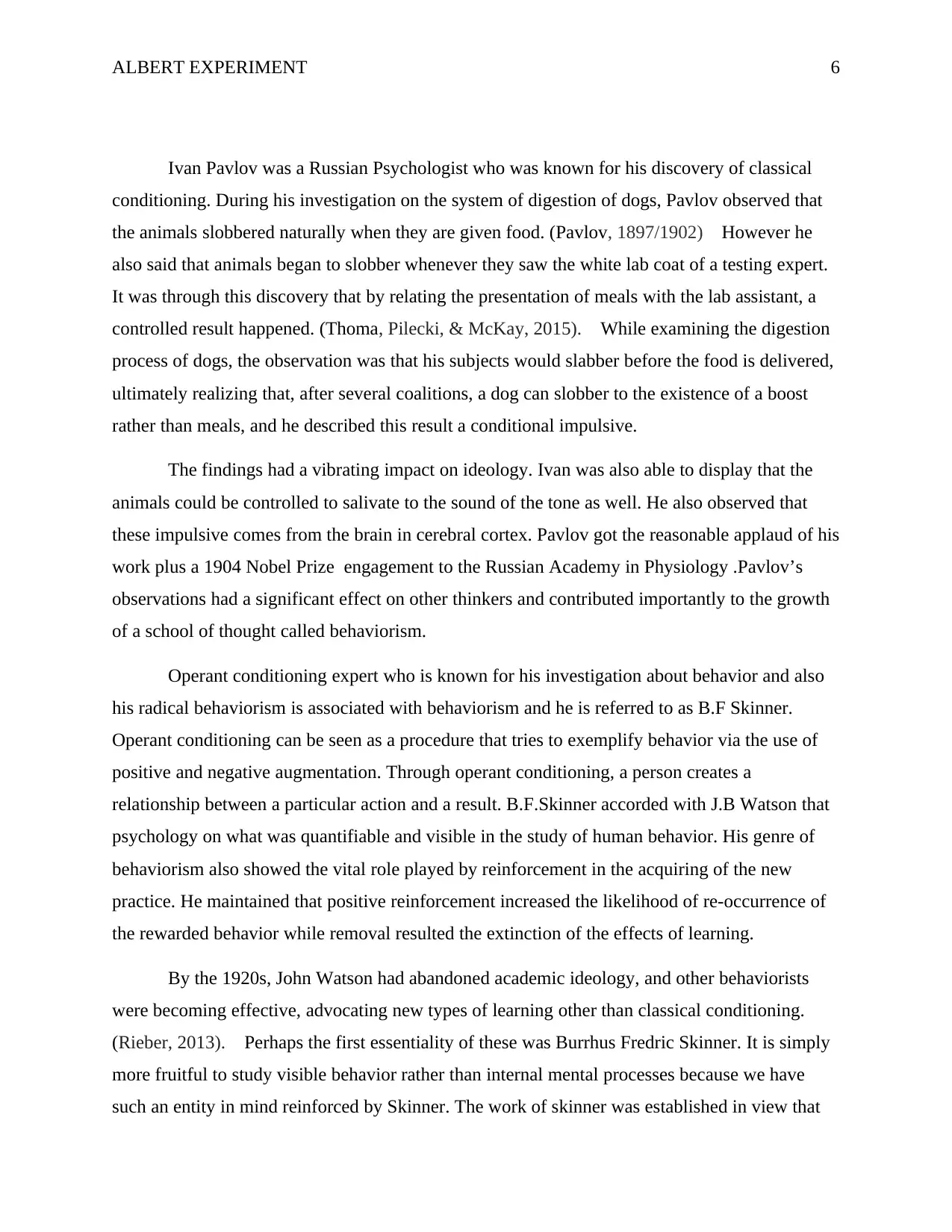
ALBERT EXPERIMENT 6
Ivan Pavlov was a Russian Psychologist who was known for his discovery of classical
conditioning. During his investigation on the system of digestion of dogs, Pavlov observed that
the animals slobbered naturally when they are given food. (Pavlov, 1897/1902) However he
also said that animals began to slobber whenever they saw the white lab coat of a testing expert.
It was through this discovery that by relating the presentation of meals with the lab assistant, a
controlled result happened. (Thoma, Pilecki, & McKay, 2015). While examining the digestion
process of dogs, the observation was that his subjects would slabber before the food is delivered,
ultimately realizing that, after several coalitions, a dog can slobber to the existence of a boost
rather than meals, and he described this result a conditional impulsive.
The findings had a vibrating impact on ideology. Ivan was also able to display that the
animals could be controlled to salivate to the sound of the tone as well. He also observed that
these impulsive comes from the brain in cerebral cortex. Pavlov got the reasonable applaud of his
work plus a 1904 Nobel Prize engagement to the Russian Academy in Physiology .Pavlov’s
observations had a significant effect on other thinkers and contributed importantly to the growth
of a school of thought called behaviorism.
Operant conditioning expert who is known for his investigation about behavior and also
his radical behaviorism is associated with behaviorism and he is referred to as B.F Skinner.
Operant conditioning can be seen as a procedure that tries to exemplify behavior via the use of
positive and negative augmentation. Through operant conditioning, a person creates a
relationship between a particular action and a result. B.F.Skinner accorded with J.B Watson that
psychology on what was quantifiable and visible in the study of human behavior. His genre of
behaviorism also showed the vital role played by reinforcement in the acquiring of the new
practice. He maintained that positive reinforcement increased the likelihood of re-occurrence of
the rewarded behavior while removal resulted the extinction of the effects of learning.
By the 1920s, John Watson had abandoned academic ideology, and other behaviorists
were becoming effective, advocating new types of learning other than classical conditioning.
(Rieber, 2013). Perhaps the first essentiality of these was Burrhus Fredric Skinner. It is simply
more fruitful to study visible behavior rather than internal mental processes because we have
such an entity in mind reinforced by Skinner. The work of skinner was established in view that
Ivan Pavlov was a Russian Psychologist who was known for his discovery of classical
conditioning. During his investigation on the system of digestion of dogs, Pavlov observed that
the animals slobbered naturally when they are given food. (Pavlov, 1897/1902) However he
also said that animals began to slobber whenever they saw the white lab coat of a testing expert.
It was through this discovery that by relating the presentation of meals with the lab assistant, a
controlled result happened. (Thoma, Pilecki, & McKay, 2015). While examining the digestion
process of dogs, the observation was that his subjects would slabber before the food is delivered,
ultimately realizing that, after several coalitions, a dog can slobber to the existence of a boost
rather than meals, and he described this result a conditional impulsive.
The findings had a vibrating impact on ideology. Ivan was also able to display that the
animals could be controlled to salivate to the sound of the tone as well. He also observed that
these impulsive comes from the brain in cerebral cortex. Pavlov got the reasonable applaud of his
work plus a 1904 Nobel Prize engagement to the Russian Academy in Physiology .Pavlov’s
observations had a significant effect on other thinkers and contributed importantly to the growth
of a school of thought called behaviorism.
Operant conditioning expert who is known for his investigation about behavior and also
his radical behaviorism is associated with behaviorism and he is referred to as B.F Skinner.
Operant conditioning can be seen as a procedure that tries to exemplify behavior via the use of
positive and negative augmentation. Through operant conditioning, a person creates a
relationship between a particular action and a result. B.F.Skinner accorded with J.B Watson that
psychology on what was quantifiable and visible in the study of human behavior. His genre of
behaviorism also showed the vital role played by reinforcement in the acquiring of the new
practice. He maintained that positive reinforcement increased the likelihood of re-occurrence of
the rewarded behavior while removal resulted the extinction of the effects of learning.
By the 1920s, John Watson had abandoned academic ideology, and other behaviorists
were becoming effective, advocating new types of learning other than classical conditioning.
(Rieber, 2013). Perhaps the first essentiality of these was Burrhus Fredric Skinner. It is simply
more fruitful to study visible behavior rather than internal mental processes because we have
such an entity in mind reinforced by Skinner. The work of skinner was established in view that
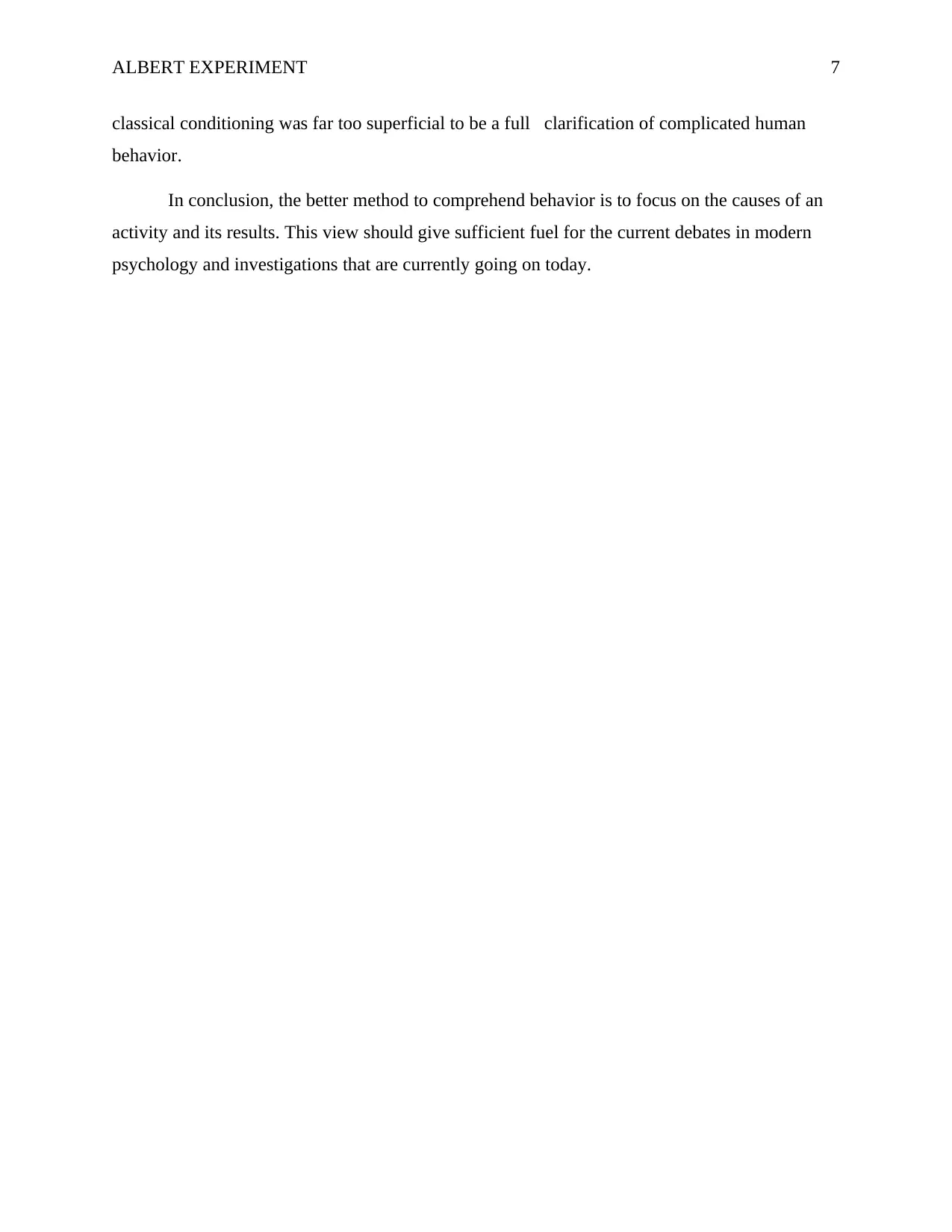
ALBERT EXPERIMENT 7
classical conditioning was far too superficial to be a full clarification of complicated human
behavior.
In conclusion, the better method to comprehend behavior is to focus on the causes of an
activity and its results. This view should give sufficient fuel for the current debates in modern
psychology and investigations that are currently going on today.
classical conditioning was far too superficial to be a full clarification of complicated human
behavior.
In conclusion, the better method to comprehend behavior is to focus on the causes of an
activity and its results. This view should give sufficient fuel for the current debates in modern
psychology and investigations that are currently going on today.
Paraphrase This Document
Need a fresh take? Get an instant paraphrase of this document with our AI Paraphraser
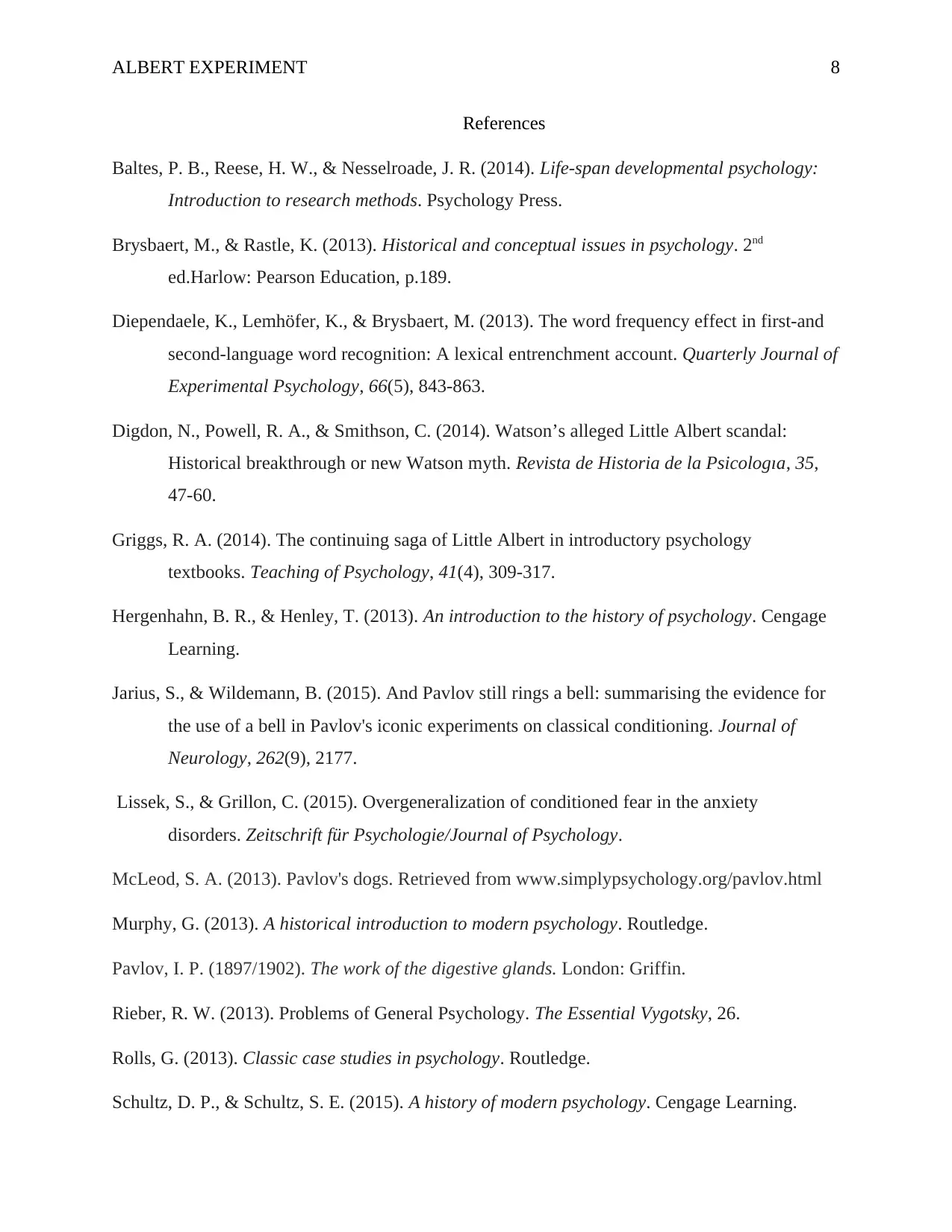
ALBERT EXPERIMENT 8
References
Baltes, P. B., Reese, H. W., & Nesselroade, J. R. (2014). Life-span developmental psychology:
Introduction to research methods. Psychology Press.
Brysbaert, M., & Rastle, K. (2013). Historical and conceptual issues in psychology. 2nd
ed.Harlow: Pearson Education, p.189.
Diependaele, K., Lemhöfer, K., & Brysbaert, M. (2013). The word frequency effect in first-and
second-language word recognition: A lexical entrenchment account. Quarterly Journal of
Experimental Psychology, 66(5), 843-863.
Digdon, N., Powell, R. A., & Smithson, C. (2014). Watson’s alleged Little Albert scandal:
Historical breakthrough or new Watson myth. Revista de Historia de la Psicologıa, 35,
47-60.
Griggs, R. A. (2014). The continuing saga of Little Albert in introductory psychology
textbooks. Teaching of Psychology, 41(4), 309-317.
Hergenhahn, B. R., & Henley, T. (2013). An introduction to the history of psychology. Cengage
Learning.
Jarius, S., & Wildemann, B. (2015). And Pavlov still rings a bell: summarising the evidence for
the use of a bell in Pavlov's iconic experiments on classical conditioning. Journal of
Neurology, 262(9), 2177.
Lissek, S., & Grillon, C. (2015). Overgeneralization of conditioned fear in the anxiety
disorders. Zeitschrift für Psychologie/Journal of Psychology.
McLeod, S. A. (2013). Pavlov's dogs. Retrieved from www.simplypsychology.org/pavlov.html
Murphy, G. (2013). A historical introduction to modern psychology. Routledge.
Pavlov, I. P. (1897/1902). The work of the digestive glands. London: Griffin.
Rieber, R. W. (2013). Problems of General Psychology. The Essential Vygotsky, 26.
Rolls, G. (2013). Classic case studies in psychology. Routledge.
Schultz, D. P., & Schultz, S. E. (2015). A history of modern psychology. Cengage Learning.
References
Baltes, P. B., Reese, H. W., & Nesselroade, J. R. (2014). Life-span developmental psychology:
Introduction to research methods. Psychology Press.
Brysbaert, M., & Rastle, K. (2013). Historical and conceptual issues in psychology. 2nd
ed.Harlow: Pearson Education, p.189.
Diependaele, K., Lemhöfer, K., & Brysbaert, M. (2013). The word frequency effect in first-and
second-language word recognition: A lexical entrenchment account. Quarterly Journal of
Experimental Psychology, 66(5), 843-863.
Digdon, N., Powell, R. A., & Smithson, C. (2014). Watson’s alleged Little Albert scandal:
Historical breakthrough or new Watson myth. Revista de Historia de la Psicologıa, 35,
47-60.
Griggs, R. A. (2014). The continuing saga of Little Albert in introductory psychology
textbooks. Teaching of Psychology, 41(4), 309-317.
Hergenhahn, B. R., & Henley, T. (2013). An introduction to the history of psychology. Cengage
Learning.
Jarius, S., & Wildemann, B. (2015). And Pavlov still rings a bell: summarising the evidence for
the use of a bell in Pavlov's iconic experiments on classical conditioning. Journal of
Neurology, 262(9), 2177.
Lissek, S., & Grillon, C. (2015). Overgeneralization of conditioned fear in the anxiety
disorders. Zeitschrift für Psychologie/Journal of Psychology.
McLeod, S. A. (2013). Pavlov's dogs. Retrieved from www.simplypsychology.org/pavlov.html
Murphy, G. (2013). A historical introduction to modern psychology. Routledge.
Pavlov, I. P. (1897/1902). The work of the digestive glands. London: Griffin.
Rieber, R. W. (2013). Problems of General Psychology. The Essential Vygotsky, 26.
Rolls, G. (2013). Classic case studies in psychology. Routledge.
Schultz, D. P., & Schultz, S. E. (2015). A history of modern psychology. Cengage Learning.
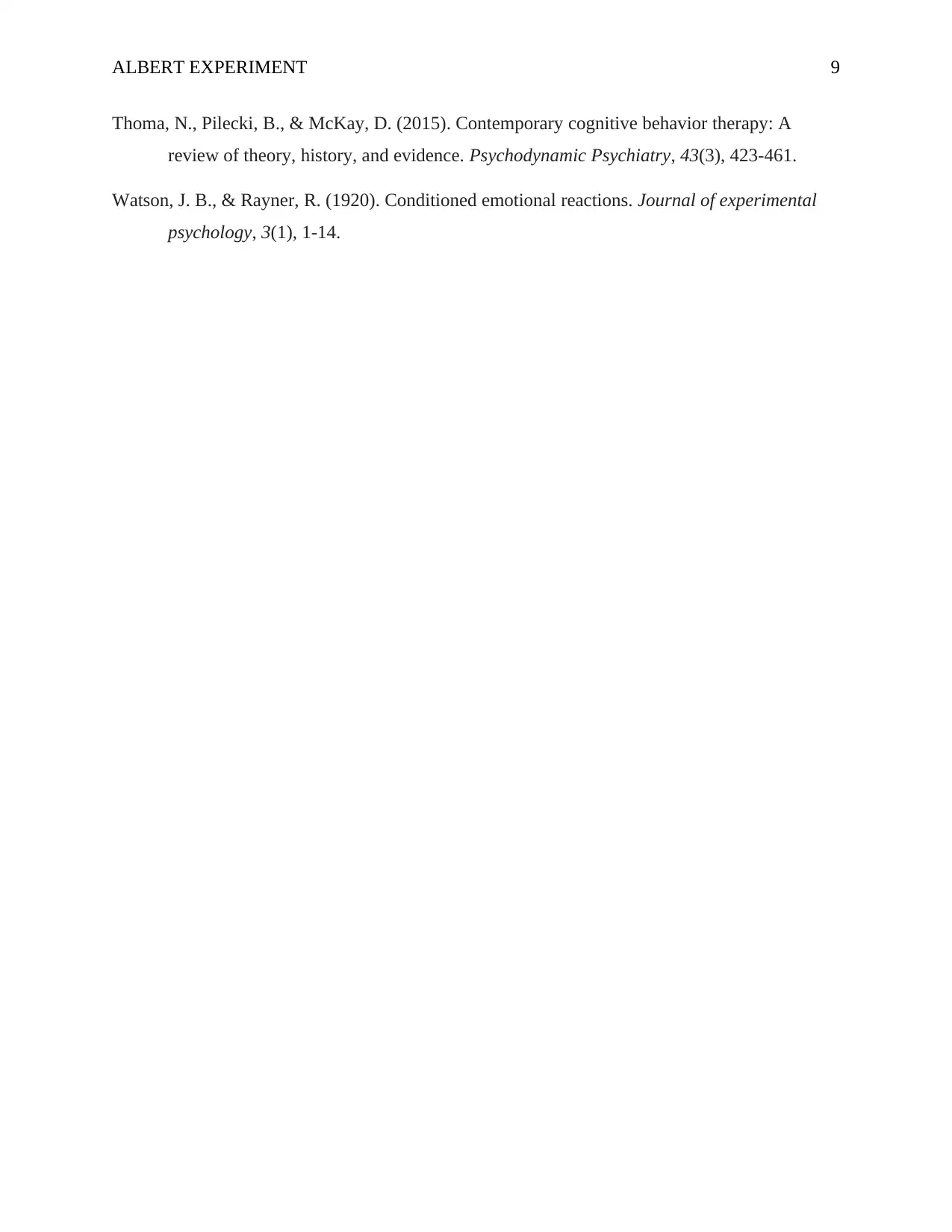
ALBERT EXPERIMENT 9
Thoma, N., Pilecki, B., & McKay, D. (2015). Contemporary cognitive behavior therapy: A
review of theory, history, and evidence. Psychodynamic Psychiatry, 43(3), 423-461.
Watson, J. B., & Rayner, R. (1920). Conditioned emotional reactions. Journal of experimental
psychology, 3(1), 1-14.
Thoma, N., Pilecki, B., & McKay, D. (2015). Contemporary cognitive behavior therapy: A
review of theory, history, and evidence. Psychodynamic Psychiatry, 43(3), 423-461.
Watson, J. B., & Rayner, R. (1920). Conditioned emotional reactions. Journal of experimental
psychology, 3(1), 1-14.
1 out of 9
Your All-in-One AI-Powered Toolkit for Academic Success.
+13062052269
info@desklib.com
Available 24*7 on WhatsApp / Email
![[object Object]](/_next/static/media/star-bottom.7253800d.svg)
Unlock your academic potential
© 2024 | Zucol Services PVT LTD | All rights reserved.
